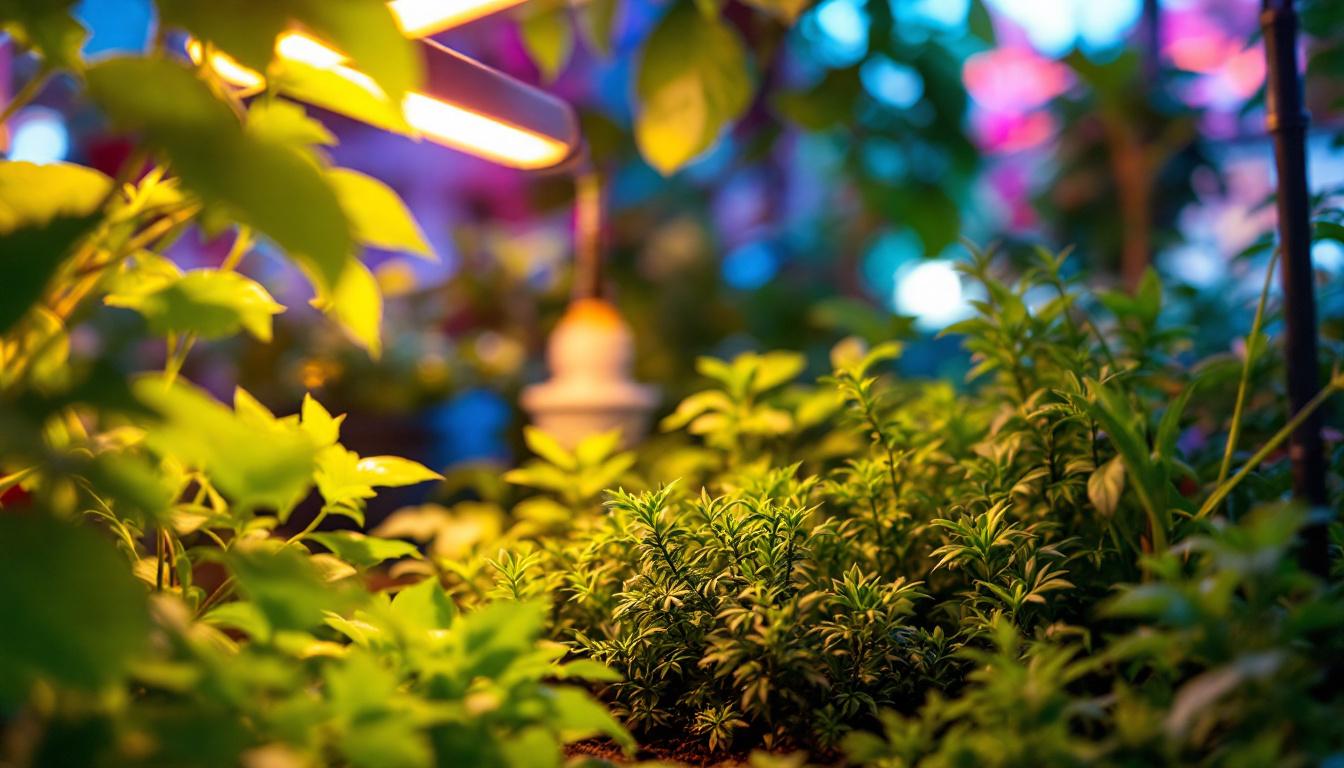
In the world of horticulture, the efficiency of lighting systems is paramount. The T5 LED grow bulb has emerged as a popular choice among lighting contractors and growers alike due to its energy efficiency and effectiveness in promoting plant growth. This article delves into how to optimize the use of T5 LED grow bulbs for maximum efficiency, ensuring that both plants and energy resources are utilized to their fullest potential.
T5 LED grow bulbs are designed to provide optimal light conditions for plant growth. These bulbs are compact and lightweight, making them easy to install in various growing environments, from small indoor gardens to larger commercial operations. The T5 designation refers to the bulb’s diameter, which is 5/8 of an inch, and these bulbs are typically available in various lengths and wattages. Their versatility allows gardeners to customize their lighting setups according to the specific needs of their plants, whether they are growing herbs on a kitchen windowsill or cultivating a diverse array of flowers in a greenhouse.
The transition from traditional fluorescent grow lights to T5 LED technology has brought several advantages. Firstly, T5 LEDs consume significantly less energy while producing the same amount of light, leading to lower electricity bills. Additionally, they have a longer lifespan compared to their fluorescent counterparts, reducing the frequency of replacements and maintenance costs. This longevity is particularly advantageous for commercial growers who rely on consistent lighting for maximum yield.
Moreover, T5 LED grow bulbs emit less heat, which helps maintain optimal growing temperatures. This feature is crucial in preventing heat stress on plants, especially in enclosed spaces where temperature control can be challenging. The ability to place these bulbs closer to plants without the risk of burning them is another benefit that enhances their efficiency. Furthermore, many T5 LED options come with adjustable color temperatures, allowing growers to fine-tune their lighting to match the specific needs of different plant species, thus maximizing growth potential.
Understanding the light spectrum is essential for optimizing plant growth. T5 LED grow bulbs are available in various spectrums, including full-spectrum, blue light, and red light. Each spectrum plays a specific role in plant development. For instance, blue light is vital during the vegetative stage, promoting healthy foliage, while red light is crucial during the flowering stage, encouraging blooming and fruiting. This targeted approach to lighting can lead to healthier plants and increased yields, making T5 LEDs a popular choice among both hobbyists and professional growers.
Selecting the right spectrum based on the growth stage of the plants can significantly enhance efficiency. Utilizing full-spectrum bulbs can also be beneficial, as they provide a balanced light source that supports all growth stages. Additionally, some advanced T5 LED systems offer programmable settings, allowing growers to simulate natural sunlight cycles, which can further enhance plant health and productivity. By mimicking the gradual changes in light intensity and spectrum that occur throughout the day, these systems can help plants thrive in a controlled environment, ultimately leading to a more successful growing experience.
Proper installation of T5 LED grow bulbs is key to maximizing their efficiency. The positioning, spacing, and height of the bulbs can all influence the effectiveness of the lighting system. Here are some best practices to consider during installation.
When installing T5 LED grow bulbs, the placement should be strategic to ensure even light distribution across the growing area. Ideally, bulbs should be positioned directly above the plants, allowing for uniform coverage. This minimizes shadows and ensures that all plants receive adequate light.
For larger growing areas, using multiple fixtures may be necessary to achieve even lighting. Spacing the bulbs appropriately is crucial; too far apart may leave dark spots, while too close can lead to excessive heat and light intensity, potentially harming the plants. Additionally, consider the type of plants being grown, as different species may have varying light requirements. For instance, leafy greens often thrive under lower light intensities, while fruiting plants may benefit from more concentrated light. Tailoring the arrangement of your T5 LED bulbs to the specific needs of your plants can significantly enhance growth rates and overall health.
The height at which T5 LED grow bulbs are hung can greatly impact their efficiency. Generally, these bulbs should be placed 6 to 12 inches above the plants during the vegetative stage and can be raised to 12 to 24 inches during the flowering stage. This adjustment helps to prevent light burn and allows plants to grow towards the light source.
Regular monitoring is essential. As plants grow, the height of the bulbs should be adjusted accordingly to maintain optimal distance and light intensity. This proactive approach ensures that plants receive consistent light without the risk of damage. Furthermore, it’s beneficial to keep an eye on the color of the leaves; signs of yellowing or stretching can indicate that the light is either too far away or too close. Implementing a systematic approach to height adjustments, perhaps by marking the height on a chart or using adjustable hangers, can streamline this process and promote a healthy growing environment.
Energy efficiency is a critical factor for lighting contractors looking to optimize T5 LED grow bulbs. By implementing energy-saving strategies, it is possible to reduce operational costs while maintaining effective lighting for plant growth.
Incorporating timers and dimmers into the lighting system can significantly enhance energy efficiency. Timers allow for precise control over the duration of light exposure, ensuring that plants receive the appropriate amount of light without unnecessary energy consumption. For instance, during the vegetative stage, plants typically require 14 to 18 hours of light, while the flowering stage may only need 12 hours.
Dimmers provide the flexibility to adjust light intensity based on the specific needs of the plants. Lowering the light output during certain growth phases can help save energy while still promoting healthy growth. This adaptability is particularly beneficial in a dynamic growing environment where conditions may change frequently.
Regularly monitoring energy consumption is essential for understanding the efficiency of the lighting system. Utilizing energy meters can provide insights into how much power the T5 LED grow bulbs are using, allowing contractors to identify any inefficiencies. By analyzing this data, adjustments can be made to optimize energy use further.
Additionally, comparing energy consumption against plant growth and yield can help determine the effectiveness of the lighting setup. This data-driven approach enables informed decisions regarding potential upgrades or changes to the lighting system.
To ensure that T5 LED grow bulbs operate at maximum efficiency over time, regular maintenance is essential. This includes cleaning, inspecting, and replacing bulbs as needed.
Dust and debris can accumulate on the surface of T5 LED grow bulbs and fixtures, reducing light output and efficiency. Regular cleaning is vital to maintain optimal performance. Using a soft, damp cloth to wipe down the bulbs and fixtures can help remove any buildup without damaging the components.
It is also important to check for any obstructions that may block light from reaching the plants. Ensuring that the growing area is tidy and free from clutter can enhance the effectiveness of the lighting system.
Conducting regular inspections of the lighting system can help identify any issues before they become significant problems. Checking for flickering lights, unusual sounds, or any signs of wear and tear can help ensure that the T5 LED grow bulbs are functioning correctly. Early detection of problems can prevent costly repairs or replacements down the line.
Additionally, keeping an eye on the electrical connections and ensuring they are secure can prevent power loss and maintain efficiency. A well-maintained system is crucial for achieving the best results in plant growth.
For those looking to take their T5 LED grow bulb setup to the next level, several advanced techniques can further optimize lighting efficiency and plant growth.
In some cases, relying solely on T5 LED grow bulbs may not provide sufficient light for optimal plant growth, especially in larger growing areas or during specific growth phases. Implementing supplemental lighting strategies can enhance overall light levels. For example, combining T5 LEDs with other lighting technologies, such as high-pressure sodium (HPS) or metal halide (MH) lights, can create a more comprehensive light spectrum.
Using supplemental lighting during critical growth stages, such as flowering, can significantly improve yields and quality. This strategy allows contractors to tailor the lighting to the specific needs of their plants, ensuring they receive the optimal light conditions for growth.
Incorporating reflective surfaces into the growing environment can maximize light efficiency. By using reflective materials on walls and ceilings, light can be redirected towards the plants, increasing overall light availability without additional energy consumption. Mylar, white paint, or specialized reflective panels can enhance the effectiveness of T5 LED grow bulbs.
Positioning plants strategically in relation to these reflective surfaces can further amplify light exposure. This approach not only maximizes the use of existing light but also contributes to a more efficient growing environment.
Optimizing T5 LED grow bulbs for maximum efficiency involves a multifaceted approach that includes understanding the technology, proper installation, energy-saving strategies, and ongoing maintenance. By implementing these best practices, lighting contractors can enhance plant growth while minimizing energy consumption and costs.
As the demand for efficient lighting solutions continues to grow, staying informed about the latest advancements and techniques in T5 LED technology will be crucial for success in the horticultural industry. With careful planning and execution, T5 LED grow bulbs can provide an effective and sustainable lighting solution for a wide range of growing applications.
Ready to elevate your lighting game with the efficiency and sustainability of T5 LED grow bulbs? Look no further than LumenWholesale, where we specialize in providing contractors with high-quality, specification-grade lighting products at unbeatable wholesale prices. Say goodbye to local distributor markups and hello to our extensive selection that meets the highest industry standards. Plus, with free shipping on bulk orders, you can stock up on premium lighting solutions without any hidden fees. Don’t compromise on quality or value – explore our collection now and discover the perfect blend of quality, affordability, and convenience at LumenWholesale.

Explore the advantages and disadvantages of using pole light LEDs for lighting contractors.

Discover how LED tape light clips are revolutionizing the lighting industry by offering contractors a competitive edge.

Discover the transformative advantages of retrofit LED lighting for contractors.

Discover how the Outlet Plug Switch is revolutionizing lighting contractor workflows—boost efficiency, safety, and flexibility.